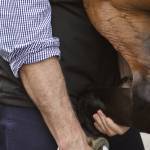Flexion Tests in Horses: How Much is Enough?

A common part of a lameness exam is a flexion test in which a horse’s leg is held in a tightly flexed position for a short period of time, after which the leg is straightened and the handler is asked to trot the horse immediately. Subtle lameness is often made increasingly obvious after flexion, with the horse showing a more irregular gait that is an aid in diagnosis.
The period of time for which the leg is to be held in a flexed position has varied among practitioners. Short periods might not significantly increase the appearance of lameness, but longer periods often led to fidgeting horses and possible danger of injury to handlers.
A study conducted at Kansas State University used 34 horses in a study to analyze the importance of flexion time in evaluating lameness. The horses ranged from completely sound to extremely lame. All horses were jogged without having been flexed and then were jogged after a five-second and a sixty-second flexion. The same veterinarian performed all flexion tests, and all jogs were recorded on videotape. A panel of 15 veterinarians watched the tapes of the unflexed jogs and post-flexion tapes that had been edited so that the duration of flexion could not be determined. There was strong correlation in the lameness assessments regardless of how long the flexion was held, suggesting that a short period of flexion is as effective as a longer period for showing lameness.
Researchers commented that, regardless of results of a flexion test, this procedure is only one tool in determining the location, severity, and cause of a horse’s lameness. Diagnosis will be more exact when several types of examination procedures are carried out.








